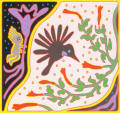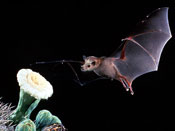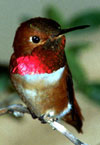Migratory Pollinators Program
Executive Summary




For over two decades, biologists have been concerned about the decline in pollinator populations, especially those that migrate across landscapes and between regions. These flyway habitats are threatened by destruction, degradation, and fragmentation due to land conversion, herbicides, pesticides, and exotic plant invasion. The nectar corridor that extends from southern Mexico north to the Intermountain West of the U.S. and Canada is of particular concern. Lesser long-nosed bats (Leptonycteris curasoae), rufous hummingbirds (Selasphorus rufus), western white-winged doves (Zenaida asiatica mearnsii), and monarch butterflies (Danaus plexippus), and other migratory pollinators move seasonally along this corridor traveling between the tropics and their northern breeding/birthing grounds. These types of migrations have been termed "endangered natural phenomena."

In past years, ASDM and its partners examined the migratory routes of these four species, and studied their biology and the floral resources upon which they depend during migration. Our field research covered approximately 1660 km (straight-line measurement) from Jalisco (south-central Mexico) to central Arizona. We also provided community outreach and education in Arizona and several states in Mexico to involve local communities in conservation efforts and in the collection of scientific data.

The North American subspecies of lesser long-nosed bat (Leptonycteris curasoae yerbabuenae) includes a population of migrators that follow two corridors in their northward spring migration (Coastal Lowland Route and Inland Montane Route; see Map 7). At least one corridor is utilized in the southward fall migration (Inland Agave Corridor), however it has not been confirmed that all bats using the Spring Coastal Lowland Route follow this Inland Agave Corridor for the return south in the fall. Pollinator mutualism between these bats and their food plants appears to vary by latitude. From roost sites, these bats travel great distances at night to find large enough patches of nectar producing plants to sustain themselves and their young, and to prepare for the next leg of their journey. Thus, protection of foraging areas near roosts is critical.
The Arizona-Sonora Desert Museum hosted an associate conservation scientist from the Wildlife Conservation Society North America Program who worked as the Bat Pollinator Corridor Project Leader. The Bat Pollinator Corridor project was part of a long term running project from WCS North America about Connectivity Conservation that will conserve wildlife areas and corridors for wildlife species at the landscape level. The nectarivore bat species in North America are endangered species that do long distance migrations in the Southwest.

Rufous hummingbirds (Selasphorus rufus) travel from Mexico to the western United States, in some cases all the way to Alaska, and back, making the longest bird migration on earth as measured in body lengths. They follow three spring (northward) nectar corridors in northwestern Mexico: Foothills Corridor, Plains of Sonora Corridor, and Gulf Coast Corridor (see Map 8). The relative importance of the three nectar corridors in the migration probably varies each year reflecting climatic and plant phenology conditions. The southward migration in late summer is less clear in the southwestern U.S. and northwestern Mexico. We know that some of these birds are flying along the higher elevations of the Sierra Madre, but some birds are also traveling a desert route.

Western white-winged doves (Zenaida asiatica mearnsii) synchronize their migration into the Sonoran Desert with the reproductive cycle of saguaro cactus (Carnegeia gigantea). They are saguaro specialists and provide important pollination services to these plants. The doves appear to fly directly from wintering to breeding grounds and vice versa. They travel north in the spring along the Pacific coastal plains and along the foothills of the Sierra Madre. The return trip south to the wintering grounds is primarily along the foothills and mountains of the Sierra Madre (See Map 9).

Monarch butterflies (Danaus plexippus) make one of the most spectacular long distance migrations known, involving up to four generations per annual cycle (Brower 1995). This complex behavior allows the monarch to exploit many, if not all of the 108 species of Asclepias (milkweed) across the North American continent, where it has become one of the most abundant butterflies in the world. Some monarchs migrate from southern Arizona into Sonora and possibly into Baja California contrary to models that show all western monarchs migrating to the California coast for overwintering.
Conclusion
Pollinators are "keystone species," linking the fate of many other species scattered over large landscapes. Continued conservation of these species will inevitably benefit overall regional and global biodiversity and the future well-being of humans. There is consensus among biologists that many migrant stopover sites have already been lost, migratory corridor habitats have been converted or fragmented, invasive plant species are out-competing native floral resources upon which these migrants depend, and many of the flowering plants these migrants visit are suffering low seed set due to pollen decline. The four species of pollinators that were the focus of this project are surrogates for the countless other migratory pollinator species that will survive only if we have a clear understanding of their biology and migrations and implement effective conservation plans.